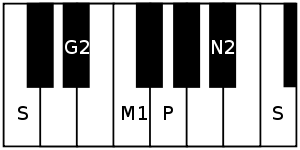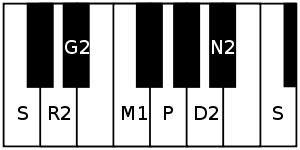Abheri
| Carnatic music |
|---|
Tanjavur-style Tambura |
| Concepts |
| Compositions |
| Instruments |
|
Abheri (pronounced ābhēri) is a raga in Carnatic music (musical scale of South Indian classical music). It is a Janya raga (derived scale), whose Melakarta raga (parent, also known as janaka) is Kharaharapriya, 22nd in the 72 Melakarta raga system.
Bhimplasi (or Bheemplas) of Hindustani music sounds pretty close to Abheri.[1][2]
Structure and Lakshana


Abheri is an audava-sampoorna raga. Its ārohaṇa-avarohaṇa structure (ascending and descending scale) is as follows (see swaras in Carnatic music for details on below notation and terms):
The swaras in this scale are Chathusruthi Rishabham, Sadharana Gandharam, Suddha Madhyamam, Chathusruthi Dhaivatham and Kaisiki Nishadham. In addition to these swaras, there are gamakas which also form part of Abheri. The ascending scale is same as that of Udayaravichandrika raga (also known as Shuddha Dhanyasi), while the descending scale is that of Kharaharapriya raga.
There are some differing views on swaras in the scale of Abheri. It is considered a Bhashanga raga (scale has an anya swara, that is, a note which is not in the parent melakarta raga, in this case Kharaharapriya raga), with introduction of Suddha Dhiavatham (D1) in some phrases of the raga.[1] A different view is that this raga is a janya of Natabhairavi (which has D1, suddha dhaivatham, in place of D2), with D2 being the anya swara (external note).[2]
This raga is closer to Bhagyasree as for Bhagyasree Gandharam is sung softly. Thus a subtle difference of Gandhara makes a listener to feel this raga as Bhagyasree.
Popular compositions
A very popular composition in Abheri raga is Nagumomu Ganaleni, a kriti by Thyagaraja, one of the three eminent composers in Carnatic music. Another well known composition is Bhajare Re Manasa, a kriti written by Mysore Vasudevachar. Muthuswami Dikshitar has composed Veenabheri in this raga. However, the Abheri of Muthuswami Dikshitar might be quite different from what is considered Abheri today.
There are many thukadas (or short songs, that are sung towards end of a Carnatic concert) composed in this raga of which Vellai Thamarai penned by Subramanya Bharathi is noteworthy. This raga has been extensively used in movie songs/ movie music. The most popular movie song in this raga is Aakaasa veedhilo from the old Telugu classic movie Malliswari (1951) sung by Ghantasala and Bhanumati.
Popular Classical Albums on this Raagam
An excellent rendition of this Raaga can be found in one of L. Shankar Albums Raga Aberi. He received a Grammy Nomination for this composition.
Related rāgams
This section covers the theoretical and scientific aspect of this rāgam.
Abheri's notes when shifted using Graha bhedam, yields 3 other janya rāgams, namely, Mohanakalyani, Kedaragaula and Arabhi (if we consider the Kharaharapriya based scale). Graha bhedam is the step taken in keeping the relative note frequencies same, while shifting the Shadjam to the next note in the rāgam. In case of Janya ragams, only notes that occur in both ascending and descending scale are taken for this change. For further details and an illustration of Graha bhedam refer Graha bhedam on Sankarabharanam. Aberi also called as Karnatakadevakanthari and Bimplasi.